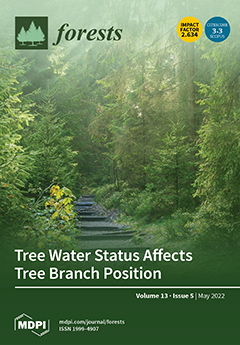Dissolved carbon (DC) in forest streams plays a crucial role in maintaining the structure and productivity of adjoining aquatic ecosystems as well as informing biogeochemical links between mountain forests and adjoining rivers. Nevertheless, the functions of forest stream DC dynamics are rarely incorporated into river management. To better understand the biogeochemical links between subalpine forests and adjoining streams, the seasonal dynamics of DC in 15 representative forest streams were investigated in a geographically fragile subalpine-gorge catchment in the upper reaches of the Yangtze River. Depending on stream characteristics and critical periods, the DC stocks in the streams ranged from 0.22 to 2.35 mg m
−2 for total DC, from 0.10 to 1.66 mg m
−2 for dissolved inorganic carbon (DIC), and from 0.12 to 1.27 mg m
−2 for dissolved organic carbon (DOC). Moreover, the annual stocks of DC, DIC, and DOC were 1.01, 0.56, and 0.45 mg m
−2, respectively. Correspondingly, the averaged export rates for DC, DIC, and DOC from the forest streams ranged from 0.27 to 1.98 mg s
−1, from 0.24 to 1.48 mg s
−1, and from 0.18 to 0.90 mg s
−1, respectively, in the subalpine forest catchment. The annual export rates of total DC, DIC, and DOC were 1.06, 0.75, and 0.31 mg C s
−1, respectively. In particular, the highest rates of export were 4.67, 3.53, and 1.34 mg s
−1 for DC, DIC, and DOC, respectively, in the snowmelt period. The average ratios of DOC to DIC stock in the export water ranged from 0.23–2.41 for the 15 streams, and the average value was 0.85 during this one-year investigation. In addition, the maximum and minimum values of the DC stocks, their exports, and the DIC:DOC ratio were consistently observed during the snowmelt season and the late growing period. In summary, precipitation, temperature, water discharge rate, and sediment depth regulated the stocks and export rates of DC and its components. In general, forest streams are important links between the carbon biogeochemical cycle of subalpine forests and adjoining streams.
Full article





